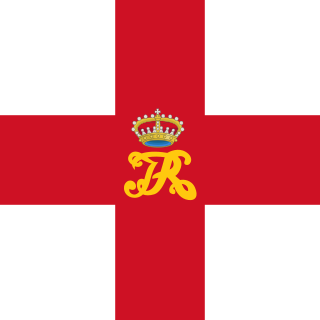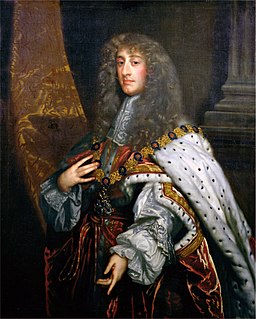
The Declaration of Arbroath is the name usually given to a letter, dated 6 April 1320 at Arbroath, written by Scottish barons and addressed to Pope John XXII. It constituted King Robert I's response to his excommunication for disobeying the pope's demand in 1317 for a truce in the First War of Scottish Independence. The letter asserted the antiquity of the independence of the Kingdom of Scotland, denouncing English attempts to subjugate it.

In the Glorious Revolution of November 1688 James II and VII, king of England, Scotland and Ireland was deposed and replaced by his daughter Mary II and her husband, stadtholder William III of Orange, the de facto ruler of the Dutch Republic. A term first used by John Hampden in late 1689, historian Jeremy Black suggests it can be seen as both the last successful invasion of England and also an internal coup.

The Bill of Rights 1689, also known as the Bill of Rights 1688, is a landmark Act in the constitutional law of England that sets out certain basic civil rights and clarifies who would be next to inherit the Crown. It received the Royal Assent on 16 December 1689 and is a restatement in statutory form of the Declaration of Right presented by the Convention Parliament to William III and Mary II in February 1689, inviting them to become joint sovereigns of England. The Bill of Rights lays down limits on the powers of the monarch and sets out the rights of Parliament, including the requirement for regular parliaments, free elections, and freedom of speech in Parliament. It sets out certain rights of individuals including the prohibition of cruel and unusual punishment and confirmed that "Protestants may have arms for their defence suitable to their conditions and as allowed by law". It also includes no right of taxation without Parliament's agreement. Furthermore, the Bill of Rights described and condemned several misdeeds of James II of England.

The monarchy of the United Kingdom, commonly referred to as the British monarchy, is the constitutional form of government by which a hereditary sovereign reigns as the head of state of the United Kingdom, the Crown dependencies and the British Overseas Territories. The current monarch is Queen Elizabeth II, who ascended the throne in 1952.
The term "English Revolution" has been used to describe two different events in English history. The first to be so-called—by Whig historians—was the Glorious Revolution of 1688, whereby James II was replaced by William III and Mary II as monarch and a constitutional monarchy was established.

John Somers, 1st Baron Somers, was an English Whig jurist and statesman. Somers first came to national attention in the trial of the Seven Bishops where he was on their defence counsel. He published tracts on political topics such as the succession to the crown, where he elaborated his Whig principles in support of the Exclusionists. He played a leading part in shaping the Revolution settlement. He was Lord High Chancellor of England under King William III and was a chief architect of the union between England and Scotland achieved in 1707 and the Protestant succession achieved in 1714. He was a leading Whig during the twenty-five years after 1688; with four colleagues he formed the Whig Junto.
The Declaration of Indulgence, also called Declaration for Liberty of Conscience, was a pair of proclamations made by James II of England and VII of Scotland in 1687. The Indulgence was first issued for Scotland on 12 February and then for England on 4 April 1687. An early step towards establishing freedom of religion in the British Isles, it was cut short by the Glorious Revolution.

The Dominion of New England in America (1686–1689) was an administrative union of English colonies covering New England and the Mid-Atlantic Colonies. Its political structure represented centralized control similar to the model used by the Spanish monarchy through the Viceroyalty of New Spain. The dominion was unacceptable to most colonists because they deeply resented being stripped of their rights and having their colonial charters revoked. Governor Sir Edmund Andros tried to make legal and structural changes, but most of these were undone and the Dominion was overthrown as soon as word was received that King James II had left the throne in England. One notable change was the introduction of the Church of England into Massachusetts, whose Puritan leaders had previously refused to allow it any sort of foothold.

Two Treatises of Government is a work of political philosophy published anonymously in 1689 by John Locke. The First Treatise attacks patriarchalism in the form of sentence-by-sentence refutation of Robert Filmer's Patriarcha, while the Second Treatise outlines Locke's ideas for a more civilized society based on natural rights and contract theory.
Early modern Britain is the history of the island of Great Britain roughly corresponding to the 16th, 17th, and 18th centuries. Major historical events in Early Modern British history include numerous wars, especially with France, along with the English Renaissance, the English Reformation and Scottish Reformation, the English Civil War, the Restoration of Charles II, the Glorious Revolution, the Treaty of Union, the Scottish Enlightenment and the formation and collapse of the First British Empire.

The Jacobite succession is the line through which Jacobites believed that the crowns of England, Scotland, and Ireland should have descended, applying primogeniture, since the deposition of James II and VII in 1688 and his death in 1701. It is in opposition to the line of succession to the British throne in law since that time.

The Claim of Right is an Act passed by the Convention of the Estates, a sister body to the Scottish Parliament, in April 1689. It is one of the key documents of United Kingdom constitutional law and Scottish constitutional law.
In political philosophy, the right of revolution is the right or duty of a people to "alter or abolish" a government that acts against their common interests and/or threatens the safety of the people without cause. Stated throughout history in one form or another, the belief in this right has been used to justify various revolutions, including the American Revolution, French Revolution, the Russian Revolution, and the Iranian Revolution.

The Declaration of Right, or Declaration of Rights, is a document produced by the English Parliament, following the 1688 Glorious Revolution. It sets out the wrongs committed by the exiled James II, the rights of English citizens, and the obligation of their monarch.

The Invitation to William was a letter sent by seven notable English nobles, later called "the Immortal Seven", to stadtholder William III, Prince of Orange, received by him on 30 June 1688. In England, the heir apparent to the throne, James Francis Edward Stuart, had just been born to the unpopular King James II of England, and baptised a Catholic. The letter asked William, who was a nephew and son-in-law of James II, to use military intervention to force the king to make his eldest daughter, Mary, William's Protestant wife, his heir. The letter alleged that the newborn prince was an impostor.

James II and VII was King of England and King of Ireland as James II, and King of Scotland as James VII from the death of his elder brother, Charles II, on 6 February 1685. He was deposed in the Glorious Revolution of 1688. He was the last Catholic monarch of England, Scotland, and Ireland. His reign is now remembered primarily for struggles over religious tolerance, but it also involved struggles over the principles of absolutism and the divine right of kings. His deposition ended a century of political and civil strife in England by confirming the primacy of the English Parliament over the Crown.
Events from the year 1688 in England. This was the year of the Glorious Revolution that overthrew King James II.

The English Convention (1689) was an assembly of the Parliament of England which met between 22 January and 12 February 1689 and transferred the crowns of England and Ireland from James II to William III and Mary II.
The regnal years of English monarchs are the official regnal years of the monarchs of the Kingdom of England from 1066, the Kingdom of Great Britain from May 1707 to January 1801, and the United Kingdom since January 1801. The regnal calendar continues to be used in many official British government and legal documents of historical interest, notably parliamentary statutes.

The Glorious Revolution in Scotland was part of a wider series of events between 1688–1689 in England and Scotland known as the Glorious Revolution. It covers the deposition of James VII, his replacement by his daughter Mary II and her husband William III of Orange and the political settlement thereafter. Scotland and England were linked but separate countries, each with its own Parliament; decisions in one did not bind the other.